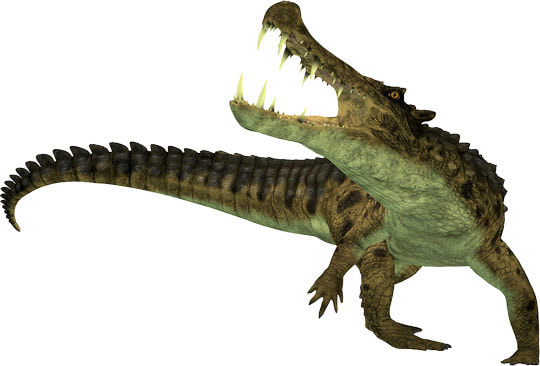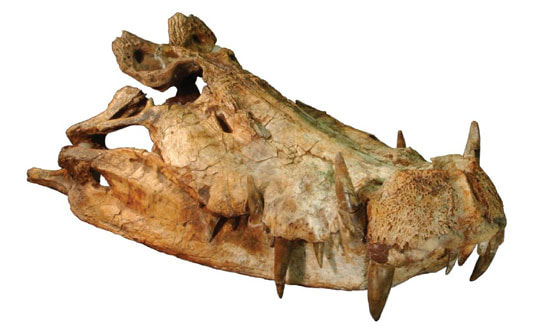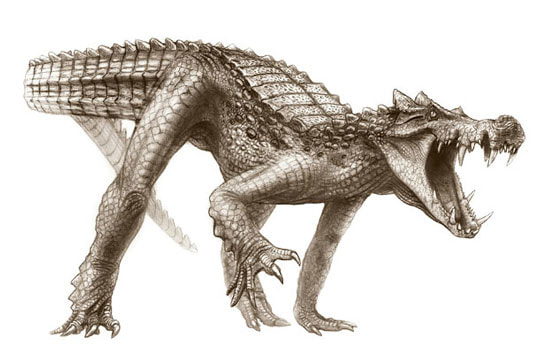|
If you haven't noticed from my previous emails, I have been featuring many of the creatures that make appearances in my novel Profusion, the third novel in the Diffusion series. Today's Awesome Animal is also in Profusion, making a brief but frightening appearance. So what the heck is a Kaprosuchus? Kaprosuchus (pronounced Kap-roe-soo-kuss) is an extinct crocodile that lived in the late Cretaceous period, about 95 to 100 million years ago. You probably know most dinosaurs became extinct soon after a large asteroid impact about 66 million years ago (except for those that evolved into birds). So Kaprosuchus lived alongside some of the dinosaurs (and probably ate them). But it was a crocodile, like our modern crocodiles, and therefore was not a dinosaur. Amazing facts about Kaprosuchus One of the most striking features of this crocodile is that it had three pairs of enormous tusk-like teeth. Which is how it got its common name, the BoarCroc. The long teeth resemble those of a wild boar. These teeth are longer than any other crocodilre teeth known. They are so long that this creature couldn't possibly have closed its mouth if it didn't have grooves in the jaws for the teeth to slide into. See the skull below: And speaking of the skull in the photo above. The ony reason we are aware this species ever existed is that this one single fossil skull has been found. It was discovered in 2009 in Niger (Africa). Everything we know about Kaprosuchus is based upon this one skull. But this skull is unique among crocodile skulls, and it can tell us quite a bit. Even though this Kaprosuchus skull was found only recently, the unusual features of this species have captured the imaginations of people worldwide, and the Kaprosuchus is featured in many illustrations, video games, and movies. You can even buy a toy Kaprosuchus, like the one below: Based on the structure of the creature's skull, it had eyes that were arranged to look forward. Most crocodiles (including all living ones today) have eyes high on the head so that they are above water when most of the rest of the body is hiding beneath the surface. Also, most crocodiles' eyes look to either side rather than ahead. Because of this forward-looking arrangement, it is assumed the Kaprosuchus had depth perception and therefore could run after prey on land. That's why most illustrations of Kaprosuchus include unusually long legs, especially the back legs. This is based on the size of the legs of other fossil crocodiles that we believe hunted on land. Even the short-legged crocodiles living today are much faster and more agile than many people realize. They can run and even jump (see the image below of a Nile crocodile being fed). This is how the Nile crocodile can catch and kill creatures like the wildebeest. So if today's short-legged, mostly-aquatic crocodiles are that fast, imagine the speed of the longer-legged terrestrial species of the past! Check out this video animation of the inferred behavior of some of the recently-discovered crocodile species (the Kaprosuchus segment starts at about two minutes). So, I believe the Kaprosuchus deserves a place in the F.A.H.O.F. (Fantasmagorical Animal Hall of Fame). FUN FACT: Fantasmagorical is no doubt derived from phantasmagoric, which means having a macabre or deceptive appearance. But this new version is more a combination of fantastic, amazing, and magical. And therefore I think the word itself is fantasmagorical! Regardless, it is another way to say awesome. Photo Credits:
Kaprosuchus Skull - Carol Abraczinskas, Wikimedia Commons Kaprosuchus #2 - Dinosaur Wiki Kaprosuchus Drawing - National Geographic, When Crocs Ruled Nile Croc Jumping - Olivier Born, National Geographic Toy Kaprosuchus - Dinosaur Toy Blog
1 Comment
|
Stan's Cogitations
Everyone needs a creative outlet. That's why I write. Archives
July 2024
|






 RSS Feed
RSS Feed